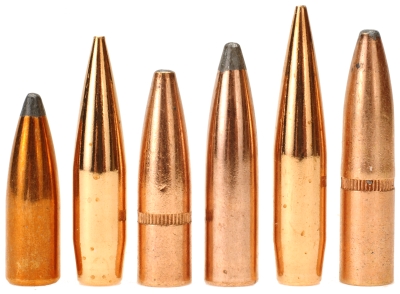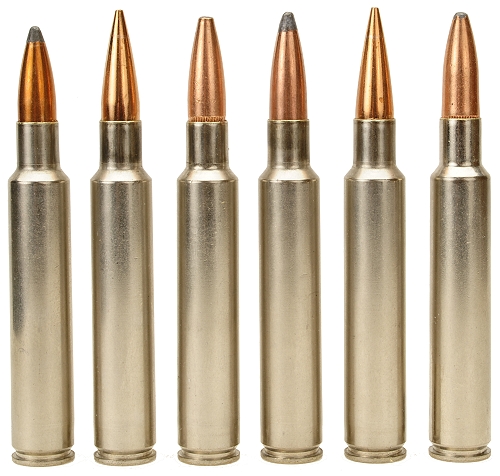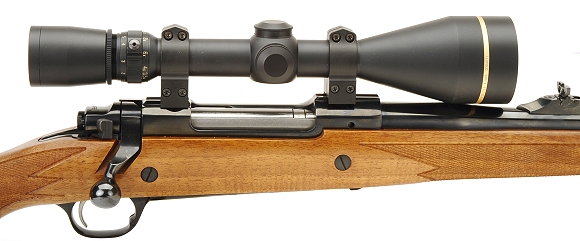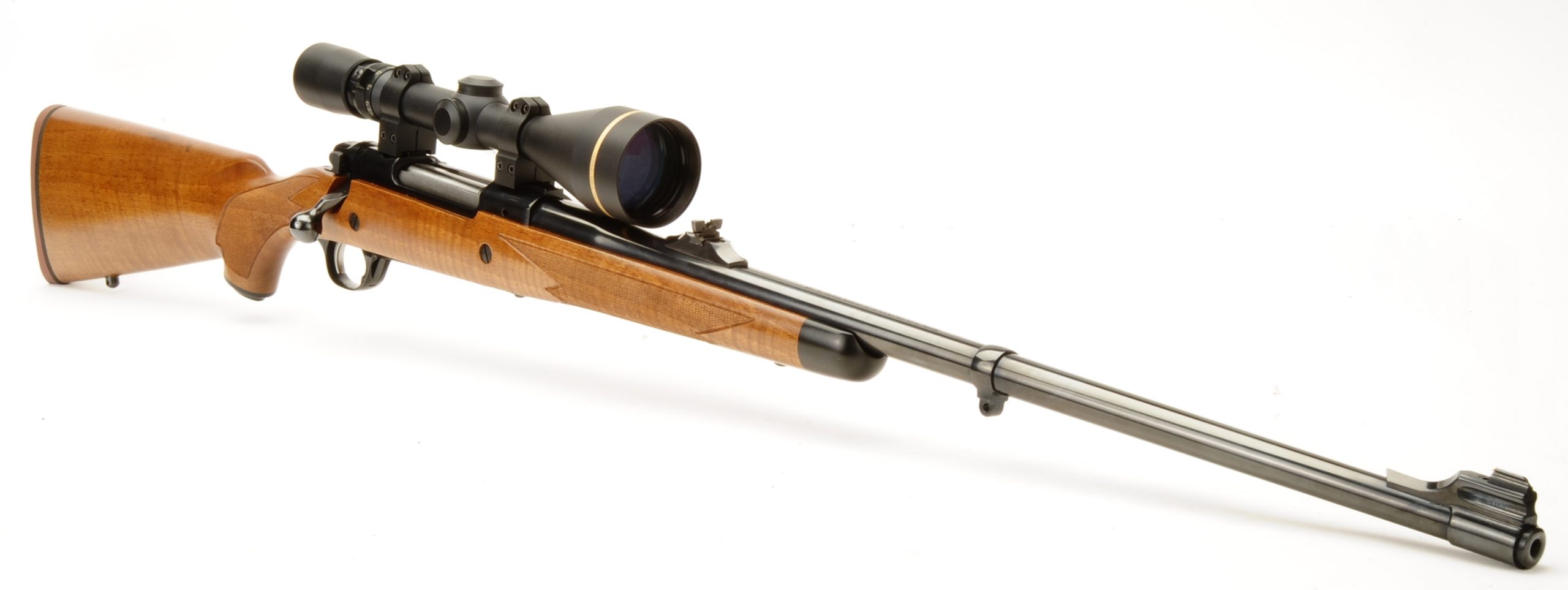I’m pretty sure, we won’t be seeing the substance of “Practical Dope on the Big Bores” popping up on a blog any time soon. The book was published at a time, 1948, when dedicated enthusiasts routinely created wildcat cartridges, made their own bullets, experimented with powder types, and poked and tweaked combinations to serve their personal applications. Ackley, to his credit, was one of those folks, one of many. There were over two dozen 280 Improved and wildcat type cartridges of record, with at least a third based on the 30-06 Springfield case and predating the 280 Remington by a couple of decades.
My intention is not to diminish the accomplishments of P.O. Ackley. In fact, it was his work that fueled my interest in firearms. He had the rare ability to create and communicate, which has served all firearm enthusiasts. Perhaps the 280 Ackley Improved cartridge, a Nosler rather than Ackley invention, is more of a tribute to Ackley and to his contemporaries. People whose ingenuity and persistence have left us with so many choices in firearms and cartridges and a varied and colorful history to build upon.
Historical Backdrop*
My 1959 copy of P.O. Ackley’s 1959 book, “Handbook For Shooters and Reloaders” is heavily notated with the fountain pen scribbling of a fourteen year old. Mostly kinetic energy calculations for all of the big cartridges being assessed for my forthcoming African Safari. Never made that trip. Never met Ackley and could not tell you if he was a good guy or a bad guy, except by reputation, but he created a positive backdrop for firearms based on innovation and ingenuity.
The 1959 edition reflects a modest Ackley, with more than two-thirds of the articles written by Ackley’s contemporaries and with credit for handload data shared with five industry sources. Ackley’s comments were even handed, even when directed at his own improved mechanical progeny, ranging from. “No real improvement” and “Too overbore” to “good improvement”. No outlandish claims, no overstated performance and a lot of credit to other wildcat and improved cartridge producers.
No 280 Ackley Improved cartridge appears in the 1959 edition of Ackley book, only the factory 280 Remington and Ackley’s 7mm/06 Ackley Improved and a few similar cartridges created by others. The greatly expanded 1962 edition of Ackley’s “Handbook For Shooters and Reloaders Part I” lists the 7mm/06 Ackley Improved on page 393 and the 280 Remington Improved, RCBS credited, on page 395. The Ackley case is slightly shorter, has a bit more body taper, the body is longer, the neck is shorter, and the shoulder angle is 39.80° compared to 32.62° for the 280 Remington Improved. In the 1959 edition, Ackley credits the .285 OKH (O’Neill, Keith and Hopkins) as the standard 7mm/06. This cartridge also carried over to the 1962 edition.
So what is the difference within this group of 7mm cartridges? Variations in body taper, shoulder angle, neck length and case capacity: 7mm/06 Ackley Improved 67.5 grains, 280 Remington Improved 67.4 grains, 280 Remington 68.6 grains, 285 OKH 70.8 grains. The differences are not immaterial as there are currently retail die sets for: 280 Remington, 280 Ackley Improved 30° shoulder, 280 RCBS 30° shoulder, 280 Ackley Improved 40° shoulder, 280 Ackley Improved, 7mm-06, and 7mm-06 Ackley Improved 40° shoulder. What to do? What to do?
SAAMI has a standard version of the improved 280 Remington with the nomenclature 280 Ackley Improved which appears to be a melding of the best aspects of all of the “improved” cartridges. The standard 280 Remington with 140 grain bullet, based on a 24″ test barrel, is rated at 2,985 fps. The 280 Ackley Improved cartridge, with the same test circumstances, is rated at 3,260 fps. Looking at the historical versions of Improved and Ackley cases, how did we get to this SAAMI cartridge?
Nosler submitted a version of the 280 Ackley Improved to SAAMI and received certification in 2014. The SAAMI version is a slightly different banana in the bunch. The case is longer than Ackley’s 7mm/06, the body is longer, less taper increases shoulder diameter, shoulder angle is 40°, and the neck is shorter. As a result, the SAAMI 280 Ackley has a 74.0 grain capacity. To further boost the Improved version’s performance MAP pressure is 65kpsi compared to 60kpsi for the standard 280 Remington.
Wow! With all of that crazy ammunition must be hard to find.
The 280 Ackley Improved is an “improved” cartridge, so standard ammunition, in this case the 280 Remington, can also be safely fired. There are approximately 18 factory loads for the 280 Remington and 12 factory loads for the 280 Ackley Improved, so 30 factory loads that are compatible with the Ruger Hawkeye African 280 AI. The difference between standard and improved 280 ammunition, which is why the Ackley Improved exists. Federal Premium 150 grain ammo is rated 3,075 fps for the 280 Ackley Improved and 2,890 fps for the same in 280 Remington, or a 185 fps difference.
I realize we live in a disposable society that routinely junk cars, computers and major appliances where failure is followed by a greater effort than a two minute head scratch, however, handloading is alive and well.As a young guy withe an interest in firearms that far outstripped a financial accommodation, I don’t think I shot a round of 243 Winchester or 25-06 Remington were not casehead stamped, respectively, 308 Winchester and 30-06 Springfield.The 280 Ackley Improved can be made from any 30-06 Springfield cartridge or 30-06 Springfield derivative.
Lots and lots… and lots of bullets
The 280 Ackley Improved, like the 280 Remington, is suitable for any medium to large North American game. In support of those applications, fourteen manufacturers produce a total of one hundred seventeen 0.284″ bullets, in weights from 100 grains to 197 grains and in many different types. No, I am too old and too slow to work one hundred seventeen bullets into a project. Six is my limit.

The six bullets selected are all lead core jacketed, but there is also a good selection of monolithic copper hunting bullets. The 120 grain Sierra is heavy enough and tough enough in construction for deer hunting, antelope hunting and probably coyote hunting. The 175 Grain Remington PSP is tough enough for very heavy bodied game. My favorites are the 140 grain Remington PSP and Speer 160 grain to the extent I also load them in both my 7mm Remington Mag and 7x57mm Mauser.
So why are the Berger VLD bullets present? I like flat base bullets because they conserve case capacity and they are all I need for the shooting distances that exist in my world. Still, I realize there are those who plan tail end shots on chipmunks at 500 yards and very low drag profile bullets are popular for that application.
There is the obvious VLD aerodynamic component, but there is also the refined construction that allows full expansion at longer distances, even after velocity has been shed. However, they still expand without fragmenting a closer distances. Sounds almost magical? Yes. I like flat based bullets and shooting at targets local to my zip code.
A very attractive cartridge that goes well with a very attractive Ruger

Once fired Federal nickle plated brass was used for the final chronograph data collection, however, fire formed 280 Remington and 30-06 Springfield brass were also used during some aspects of the process. If I don’t get too lazy, I will wet check all to see if, or to what degree, case capacity varies. Lee Precision dies were used for assembly, including a collet crimp die. Lee was selected because they were readily available and, unlike some other manufacturers, they do not pretend that the 280 AI is a “special” cartridge and attempt to 2x mark up the price.
For folks with Hornady headspace gauges and similar, even with the revised shoulder angle, the 280 Ackley Improved has the same 0.375″ headspace diameter at the datum point and can use the standard Hornady 0.375 gauge bushing as also used for the 280 Rem and most of the other 30-06 based cartridges… and the 6.5 Creedmoor… and the 30-30 WCF… and the 300 H&H Magnum. Someone please stop me from listing.
| Improved Versions of the 280 Remington |
Dry Weight Grains |
Wet Weight Grains |
Grains H2O Capacity |
| Federal AI (New) | 204.6 | 278.2 | 73.6 |
| Federal 280 Ackley Improved | 204.8 | 279.5 | 74.7 |
| Made from 280 Remington | 203.0 | 277.7 | 74.7 |
| Made from 30-06 Springfield | 198.4 | 272.0 | 73.6 |
| Brass Source Once Fired, except as noted. Standard Remington 280 capacity 68.6 grains H2O |
|||
I took the plunge, broke out the gear and checked spillover full volume as posted on the table above. The nominal H2O capacity for the 280 Remington is 68.6 grains. Nominal capacity for the 280 Ackley Improved is 74.0 grains*. Made from brass was Remington manufacturer.
Handload Data
Warning: Bullet selections are specific, and loads are not valid with substitutions of different bullets of the same weight. Variations in bullet length will alter net case capacity, pressure and velocity. Primer selection is specific and primer types are not interchangeable. These are maximum loads in my firearms and may be excessive in others. All loads should be reduced by 5% as a starting point for development where cartridges have greater than 40 grains in capacity and 10% for cartridges with less than 40 grain capacity following safe handloading practices as represented in established mainstream reloading manuals. Presentation of these loads does not constitute a solicitation for their use, nor a recommendation.

| Cartridge – 280 Ackley Improved 65kpsi |
|
| Firearm | Ruger M77 |
| Barrel Length | 24.00″ |
| Min – Max Case Length | 2.525″ +0.000″/-0.012″ |
| Min – Max COL | 3.136″ – 3.330″ |
| Primer | CCI 250 |
| Bullet Diameter | 0.2845″ +0.000″/-0.0030″ |
| Reloading Dies | Lee Precision |
| Bullet Type | Bullet Weight Grains |
Net H2O Grains Capacity |
COL” | Powder Type | Powder Charge Grains |
Muzzle Velocity fps |
Muzzle Energy ft/lbs |
3 Shot 100 Yd Group ” |
| Sierra Pro-Hunter |
120 | 70.2 | 3.200 | RL 17 | 60.5 | 3456 | 3183 | 0.7 |
| Sierra Pro-Hunter | 120 | 70.2 | 3.200 | IMR 4350 | 60.5 | 3306 | 2913 | 0.9 |
| Sierra Pro-Hunter | 120 | 70.2 | 3.200 | Win 760 | 60.5 | 3346 | 2984 | 0.6 |
| Berger VLD Hunting |
140 |
66.4 |
3.330 |
RL 19 |
60.0 |
3131 |
3048 |
0.5 |
| Berger VLD Hunting |
140 |
66.4 |
3.330 |
Hybrid 100V |
56.0 |
3054 |
2900 |
0.7 |
| Berger VLD Hunting |
140 |
66.4 |
3.330 |
RS Hunter |
60.5 |
3141 |
3068 |
0.8 |
| Remington PSP | 140 | 68.4 | 3.290 | RL 22 | 63.5 | 3182 | 3148 | 0.8 |
| Remington PSP | 140 | 68.4 | 3.290 | Norma MRP | 64.0 | 3272 | 3329 | 1.0 |
| Remington PSP | 140 | 68.4 | 3.290 | RS Hunter | 61.0 | 3056 | 2904 | 0.9 |
| Speer SP | 160 | 66.4 | 3.300 | RL 19 | 59.5 | 2981 | 3158 | 0.6 |
| Speer SP | 160 | 66.4 | 3.300 | IMR 7828 SSC | 60.5 | 2974 | 3143 | 0.8 |
| Speer SP | 160 | 66.4 | 3.300 | Norma MRP | 60.0 | 2896 | 2980 | 0.6 |
| Berger VLD Hunting |
168 |
64.6 |
3.330 |
RL 22 |
59.0 |
2839 |
3007 |
0.5 |
| Berger VLD Hunting | 168 | 64.6 |
3.330 |
Hybrid 100V |
52.8 |
2775 |
2873 |
0.7 |
| Berger VLD Hunting | 168 | 64.6 |
3.330 |
RS Hunter |
56.0 |
2806 |
2938 |
0.3 |
| Remington PSP | 175 | 65.6 | 3.285 | RL 22 | 58.0 | 2745 | 2929 | 0.6 |
| Remington PSP | 175 | 65.6 | 3.285 | Hybrid 100V | 52.5 | 2680 | 2792 | 0.9 |
| Remington PSP | 175 | 65.6 | 3.285 | IMR 7828 SSC | 58.0 | 2756 | 2952 | 0.7 |
Notes: Someone once posted that I do not make notes available. I don’t know what that means, outside of the quantification noted. So I now try to end with some pithy comments to appease people who always want more.
The first three 120 grain loads really do get the same change weight with three different powders. Not a typo.
Hybrid 100V, which I thought would be the star going in, was lackluster going out. Just add more powder? Not really, as more left a very detailed tattoo of the bolt face on the case head.
Both RS Hunter and Norma MRP worked well. If it wasn’t maximum velocity, they both delivered good accuracy. IMR 7828 SSC is a great powder and, I suspect, I should use it more… considering I have about 80 lbs in reserve for 30-06 length belted magnum use.
What might they look like in flight?
| Best Zero Results – 120 Grain Sierra | |||||||
| Near-Zero – yds. | 30 | Mid Range – yds. | 158 | ||||
| Far-Zero – yds. | 276 | Max Ordinate – in. | +3.0 | ||||
| Point Blank – yds. | 293 | ||||||
| Best Zero : Range 0 – 500 yards | ||||||||||||
| Yards | 0 | 50 | 100 | 150 | 200 | 250 | 300 | 350 | 400 | 450 | 500 | |
| Velocity – fps | 3456 | 3294 | 3138 | 2988 | 2843 | 2702 | 2565 | 2433 | 2305 | 2181 | 2061 | |
| Energy – ft.-lbs. | 3182 | 2890 | 2623 | 2379 | 2153 | 1945 | 1753 | 1577 | 1415 | 1267 | 1131 | |
| Momentum – lbs-sec | 59 | 56 | 54 | 51 | 49 | 46 | 44 | 42 | 40 | 37 | 35 | |
| Path – in. | -1.50 | 0.81 | 2.33 | 2.96 | 2.61 | 1.19 | -1.42 | -5.35 | -10.76 | -17.79 | -26.66 | |
| Drift – in. | 0.00 | 0.00 | 0.00 | 0.00 | 0.00 | 0.00 | 0.00 | 0.00 | 0.00 | 0.00 | 0.00 | |
| Time Of Flight – sec. | 0.00 | 0.04 | 0.09 | 0.14 | 0.19 | 0.25 | 0.30 | 0.36 | 0.43 | 0.49 | 0.56 | |
| Best Zero Results – 140 Grain Remington | |||||||
| Near-Zero – yds. | 29 | Mid Range – yds. | 153 | ||||
| Far-Zero – yds. | 269 | Max Ordinate – in. | +3.0 | ||||
| Point Blank – yds. | 286 | ||||||
| Best Zero : Range 0 – 500 yards | ||||||||||||
| Yards | 0 | 50 | 100 | 150 | 200 | 250 | 300 | 350 | 400 | 450 | 500 | |
| Velocity – fps | 3272 | 3144 | 3019 | 2898 | 2780 | 2665 | 2553 | 2444 | 2337 | 2233 | 2133 | |
| Energy – ft.-lbs. | 3328 | 3071 | 2834 | 2611 | 2403 | 2208 | 2026 | 1856 | 1698 | 1550 | 1414 | |
| Momentum – lbs-sec | 65 | 63 | 60 | 58 | 56 | 53 | 51 | 49 | 47 | 45 | 43 | |
| Path – in. | -1.50 | 0.90 | 2.42 | 2.98 | 2.51 | 0.92 | -1.90 | -6.05 | -11.66 | -18.85 | -27.80 | |
| Drift – in. | 0.00 | 0.00 | 0.00 | 0.00 | 0.00 | 0.00 | 0.00 | 0.00 | 0.00 | 0.00 | 0.00 | |
| Time Of Flight – sec. | 0.00 | 0.05 | 0.10 | 0.15 | 0.20 | 0.25 | 0.31 | 0.37 | 0.43 | 0.50 | 0.57 | |
| Best Zero Results – 168 Grain Berger VLD | |||||||
| Near-Zero – yds. | 26 | Mid Range – yds. | 138 | ||||
| Far-Zero – yds. | 245 | Max Ordinate – in. | +3.0 | ||||
| Point Blank – yds. | 262 | ||||||
| Best Zero : Range 0 – 500 yards | ||||||||||||
| Yards | 0 | 50 | 100 | 150 | 200 | 250 | 300 | 350 | 400 | 450 | 500 | |
| Velocity – fps | 2839 | 2766 | 2695 | 2625 | 2555 | 2487 | 2420 | 2354 | 2290 | 2226 | 2163 | |
| Energy – ft.-lbs. | 3006 | 2854 | 2709 | 2569 | 2436 | 2308 | 2185 | 2068 | 1955 | 1848 | 1745 | |
| Momentum – lbs-sec | 68 | 66 | 65 | 63 | 61 | 60 | 58 | 57 | 55 | 53 | 52 | |
| Path – in. | -1.50 | 1.14 | 2.65 | 2.96 | 2.01 | -0.27 | -3.96 | -9.13 | -15.86 | -24.26 | -34.41 | |
| Drift – in. | 0.00 | 0.00 | 0.00 | 0.00 | 0.00 | 0.00 | 0.00 | 0.00 | 0.00 | 0.00 | 0.00 | |
| Time Of Flight – sec. | 0.00 | 0.05 | 0.11 | 0.16 | 0.22 | 0.28 | 0.34 | 0.41 | 0.47 | 0.54 | 0.61 | |
Clearly, the 280 Ackley Improved represents a very flat shooting rifle – cartridge combination. Above or below line of sight by no more than +- 3″, even a 168 grain heavyweight is point blank at 250 + yards, yet the cartridge is not a velocity scorcher that will convert bullets to grit inside of 100 yards. Very important in places like Maine where deer are notorious for hiding behind trees twenty yards away and thumbing their antlers at hunters.
Last words?
The more I shot the Ruger Hawkeye Africa, the more I came to appreciate its features. The stock geometry and rifle weight mitigated recoil and made shooting the rifle accurately, easier.
The bolt throw was really slick. None of that “Ran over a rut in the road” found in Mauser types at half stroke. I like the longish barrel and adjustable metallic sights. A relatively tight group at hundred yard was possible even with my time worn eyes.
I like the intuitive and very positive horizontal swing safety and I liked the operation of the hinged floorplate when dumping ammo. The LC6 trigger is very clean and with no creep and minimum overtravel.
I really like the 280 AI cartridge. Good shooting in factory form, it also gave me a handloader’s opportunity to work up load data and case form. The 280 Ackley Improved is significantly lighter recoiling than my 7mm Rem Mag, easier on brass and it consumes less powder for not a lot less velocity.
The subject rifle, like most African Hawkeyes is really pretty. It is hard to grumble about a good shooting rifle that also looks good. Nice gun.
* Sources: Handbook for Shooters and Reloaders 1959 – Ackley, Handbook for Shooters and Reloaders Part 1 1962 – Ackley, Handloader’s Manual of Cartridge Conversion – Donnelly, Design and Forming Custom Cartridges – Howell, The Gunsmith’s Book of Chamber Prints – PT&G, Practical Dope on the Big Bore” by F.C. Ness



Email Notification